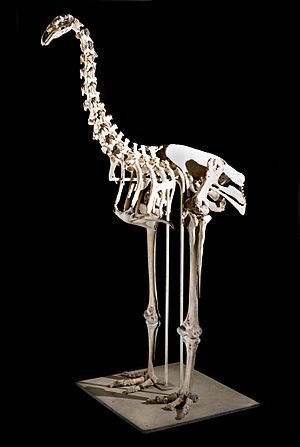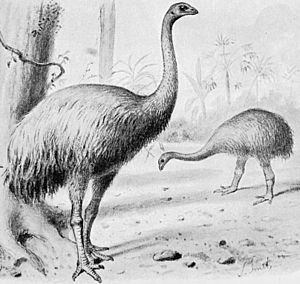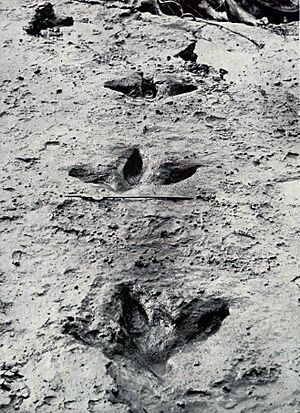South Island giant moa facts for kids
Quick facts for kids South Island giant moaTemporal range: Late Holocene
|
|
|---|---|
 |
|
| Skeleton | |
| Conservation status | |
| Scientific classification | |
| Genus: |
Dinornis
|
| Species: |
robustus
|
| Synonyms | |
|
List
Dinornis ingens var. robustus Owen, 1846
Palapteryx robustus (Owen 1846) Owen 1851a Dinornis maximus Haast 1869 Dinornis altus Owen 1879 Dinornis validus Hutton 1891 Dinornis potens Hutton 1891 Dinornis strenuus Hutton 1893 Dinornis torosus Hutton 1891 Palapteryx plenus Hutton 1891 |
|
The South Island giant moa (Dinornis robustus) was a huge, flightless bird that lived in New Zealand. It belonged to a group of birds called moas, which were all known for being very large and unable to fly. This amazing bird was a type of ratite, which means it had a flat sternum (breastbone) without a keel. A keel is usually where flight muscles attach.
Scientists now think that the very first ancestors of these birds could actually fly! They believe these early birds flew to the southern parts of the world where moa fossils have been found. Over time, they lost the ability to fly and grew to incredible sizes.
Contents
Discovering the South Island Giant Moa
The South Island giant moa was the biggest of all the moa species. Imagine a bird so tall it could look into a second-story window! Adult female moa could stand up to 2 meters (6 feet 6 inches) high at their backs. They could even reach leaves and branches up to 3.6 meters (11 feet 10 inches) off the ground. This made them the tallest bird species ever known.
Only one almost complete moa egg has been found and linked to the South Island giant moa. It was discovered near Kaikōura in New Zealand. This egg was huge, measuring 240 millimeters (about 9.4 inches) long and 178 millimeters (about 7 inches) wide. It's the largest moa egg ever found in museum collections!
Where Did the Giant Moa Live?
The South Island giant moa lived only on the South Island of New Zealand. It preferred to live in the lowlands. Its home included many different types of environments:
- Shrubland
- Duneland (sandy areas near the coast)
- Grassland
- Forests
This shows that the giant moa was able to adapt to various landscapes across the South Island.
Why Did the Giant Moa Disappear?
Sadly, the South Island giant moa, along with all other moa species, became extinct. This happened after humans arrived in New Zealand. The main reason for their disappearance was hunting by humans. As more people settled on the islands, the moa were hunted for food and their numbers quickly dropped. Within a few centuries of human arrival, these magnificent birds were gone forever.
See also
 In Spanish: Moa gigante de la isla Sur para niños
In Spanish: Moa gigante de la isla Sur para niños



